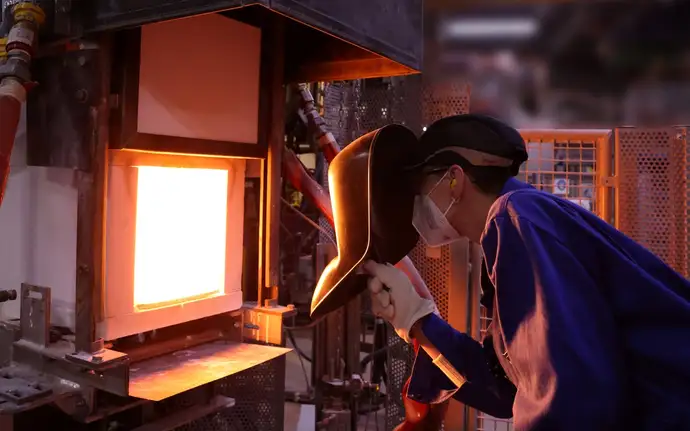Premiere: SCHOTT produces optical glass with 100 percent hydrogen
Tuesday, 16 April 2024, Mainz, Germany
-
Big step towards climate-friendly specialty glass production
-
First glass made exclusively from a hydrogen-heated furnace
-
Lack of green hydrogen infrastructure delays industrial use

The test manager emphasizes that the experience gained from last year's tank tests with an initial 35 percent hydrogen-by-volume tremendously helped with this success, but also asserts that there are still many unanswered questions requiring further research. For example: How does the use of hydrogen impact the complex melting processes, and therein, the quality of different products? What long-term effects does heating with hydrogen have on the plant itself? And what infrastructure needs to be adapted in order for hydrogen to be optimally used as a substitute for natural gas in operations?
To answer these questions, SCHOTT chose an optical glass as the first test product. Background: The technology group manufactures over 100 types of optical glass from high-quality raw materials for various applications, such as consumer goods and measurement technology, as well as optical systems in research and development. The challenge is that the glass must have the highest homogeneity and transmission properties. This also applies to the molten glass, which undergoes strict quality testing.
If the glass meets the high product requirements, it will be sent to the customer. "We would then have confirmation that the use of 100 percent hydrogen instead of fossil fuels delivers the same quality under industrial conditions," says Deneke. A permanent changeover would then also require further long-term tests and a continuous supply via a hydrogen pipeline. Only then would the Group have taken another important step towards its strategic goal of climate-neutral glass production by 2030. In this context, climate-neutral means no Scope 1 or 2 emissions according to the Greenhouse Gas Protocol. SCHOTT is pursuing this goal with activities in four fields of action: Technology change (such as the switch to green hydrogen), expansion of energy efficiency, conversion to 100 percent green electricity and, as a final step, the compensation of remaining emissions through involvement in climate protection projects.
SCHOTT has already achieved the switch to 100 percent green electricity, and energy efficiency is being continuously and systematically increased. The technology change is primarily about replacing natural gas for the operation of the furnaces. Either through electrification with green electricity or in future through the use of green hydrogen. To this end, SCHOTT had already carried out the first large-scale tests with local partners towards the end of 2022 with 35 percent hydrogen added to natural gas, before laboratory tests with 100 percent hydrogen use followed in spring 2023, paving the way for large-scale industrial use.
Challenges in infrastructure: green hydrogen is in short supply
For the large-scale tank test with 100 percent hydrogen heating, the hydrogen tank at SCHOTT in Mainz was filled three times – but with gray, not green, climate-neutral hydrogen. This is because hydrogen produced using renewable energies is currently still in short supply. "We deliberately decided to use it so that we wouldn't lose any time testing its technical feasibility. This is sufficient for our tests, but we urgently need green energy for climate protection," says Dr Frank Heinricht, Chairman of the Board of Management at SCHOTT and responsible for the Group's sustainability strategy. The appeal to politicians: "Companies from energy-intensive industries need to set the course for the fastest possible development of a functioning infrastructure for green electricity and green hydrogen in Germany. Then our commitment will pay off, for the climate and for the competitiveness of our industry."
In addition to its own investments, SCHOTT receives financial support from various institutions for its developmental work in the field of hydrogen. The tests were supported by the Federal Ministry of Education and Research BMBF and the DLR project management organization in the MiGWa project as well as "Financed by the European Union-NextGenerationEU".
Together with the Rhineland-Palatinate Ministry for Climate Protection, Environment, Energy and Mobility, the project "H2 Industry - Use of Hydrogen in Industrial Combustion Processes" was funded by the European Union from the European Regional Development Fund.
The Kopernikus project "Power-to-X" was funded by the Federal Ministry of Education and Research BMBF.
Learn more about SCHOTT's climate protection activities
Inspection of a glass bar: The large-scale test received excellent marks, and the quality of the glass is now being analyzed. Photo: SCHOTT
SCHOTT manufactures over 100 types of optical glass for various applications from high-quality raw materials. Photo: SCHOTT
SCHOTT receives financial support from various institutions for its development work in the field of hydrogen. Photo: SCHOTT
About SCHOTT
International technology group SCHOTT produces high-quality components and advanced materials, including specialty glass, glass-ceramics, and polymers. Many SCHOTT products have high-tech applications that push technological boundaries, such as flexible glass in foldable smartphones, glass-ceramic mirror substrates in the world's largest telescopes, and laser glass in nuclear fusion. With their pioneering spirit, SCHOTT’s 17,050 employees in over 30 countries work as partners to industries such as healthcare, home appliances, consumer electronics, semiconductors, optics, astronomy, energy, and aerospace. In fiscal year 2023, SCHOTT generated 2.9 billion euros in sales. In addition to innovation, one of its important corporate goals is sustainability, where it is pursuing climate neutral production by 2030. SCHOTT was founded in 1884 and is headquartered in Mainz, Germany. The company belongs to the Carl Zeiss Foundation, which uses its dividends to promote science. Further information at SCHOTT.com

Jonas Spitra
Head of Sustainability Communications



